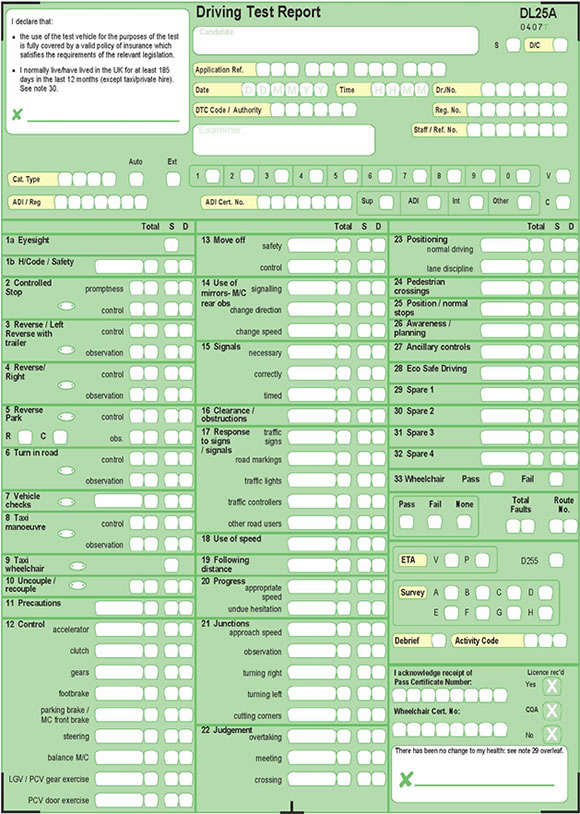Many of you will know that when you take a driving test in the UK it will be completed by the Driving Standards Agency and you will have to visit a driving test centre. In the case of the practical driving test, there is a set format to the test which is undertaken by the examiner. The sheets used for marking your test are a DL25 and each page is carbonated.
On arriving you will be asked to sign the to say you are who you say you are and that you have insurance for the vehicle.
Then the test begins. Your eyesight will be checked and you must be able to read a number plate from 20.5 metres away and if you can this gets you a tick on the sheet. All other ticks are not good news and will be one of the following,
Minor Driver Fault – You are allowed 15 of these across the test but an accumulation of too many in one area and this is considered a repeated fault and is then converted into a Serious Driving Fault. It will depend on the topic as to how many minor faults you are allowed before it converts into a serious fault e.g. checking mirrors before changing speed = 4 to 5 minor marks before conversion, checking the blind spot before pulling away = 2 or 3 times will convert to a serious.
Serious Driver Fault – A serious driver fault equals a fail. This kind of fault can be a number of things including, forcing your way through, making someone else stop, swerve etc or clipping a kerb during a manoeuvre but the most common serious faults are to do with observations.
Dangerous Driver Faults – These again will cause you to fail. These are exactly what they say they DANGEROUS. If during your test you do something the examiner deems dangerous they will mark the sheet accordingly. A dangerous action could include pulling out on someone or loosing your lane discipline and moving across in front of someone else.
Please note that you can get more than 1 mark for an action. For instance if you perform a reverse to the left around a corner and go to fast and hit the kerb whilst not checking up the road because you don’t have time. This could cause you to get a mark for hitting the kerb and one for not performing the observations. These were the results but not the problem. The problem was the speed, going too fast mean’t you wouldn’t have time to do the required things. This is why manoeuvre’s are only marked on “Control” and “Observation”.
Please do not try and read the sheet during the test as you should be concentrating on driving not what the examiner has marked. Drive like you are going to pass regardless of mistakes.
At the end of the test the examiner will add up any marks and let you know the result. You will be given a copy of the marking sheet.
If you don’t have your instructor in the back of the car during your test then I would strongly suggest you get them to listen in on the debrief, as all you will hear is “Pass” or “Fail”. It is important that you know what mistake you made, if any.



Nice post. I used to be checking continuously this weblog and I’m impressed! Extremely helpful information specially the remaining section 🙂 I deal with such information a lot. I used to be seeking this particular info for a very lengthy time. Thanks and best of luck.
Definitely consider that that you said. Your favourite reason appeared to be at the web the simplest thing to be aware of. I say to you, I definitely get irked even as other folks think about issues that they just don’t realize about. You controlled to hit the nail upon the highest and defined out the entire thing without having side effect , other people could take a signal. Will probably be again to get more. Thank you
Wow, this piece of writing is nice, my younger sister is analyzing these kinds of things,
thus I am going to inform her.
Thanx for the energy, continue to keep up the great deliver the results Good function, I’m going to start out a small Web site Engine course get the job done working with your site I wish you like blogging with the well-known BlogEngine.web.Thethoughts you express are certainly awesome. Hope you can appropriate some a lot more posts.